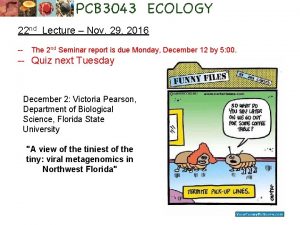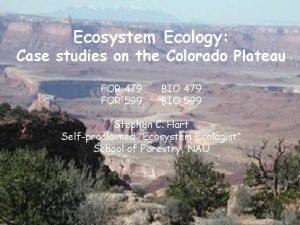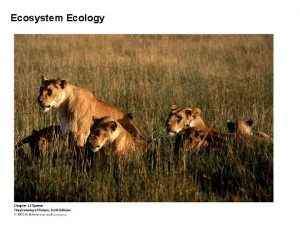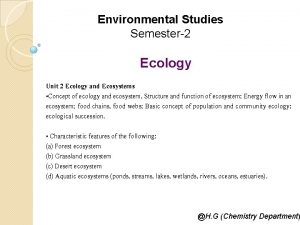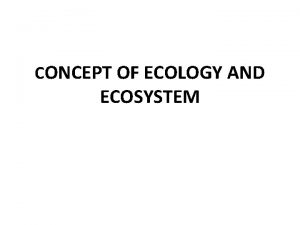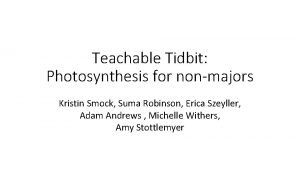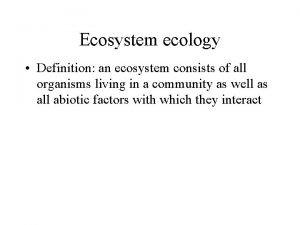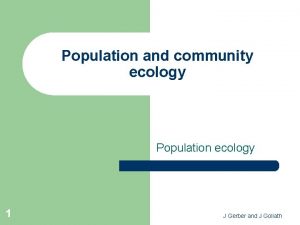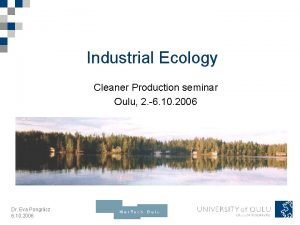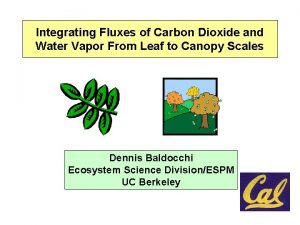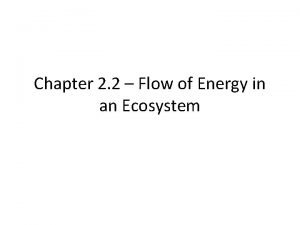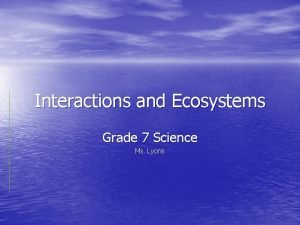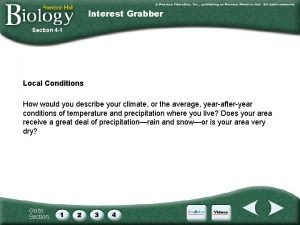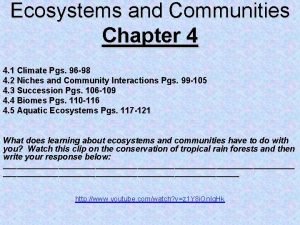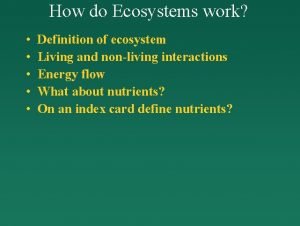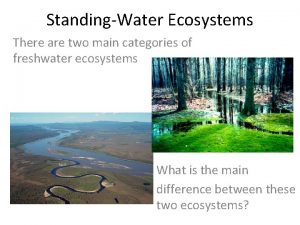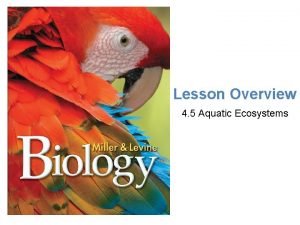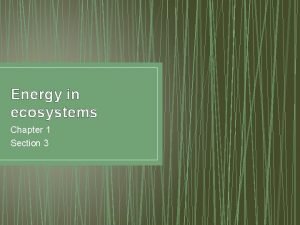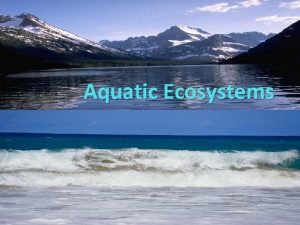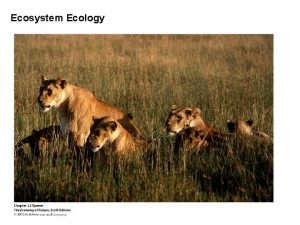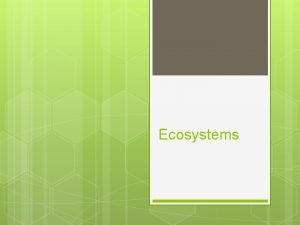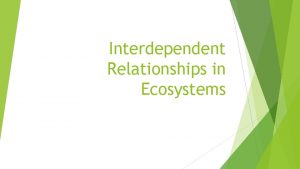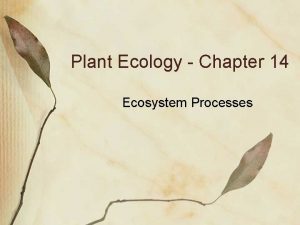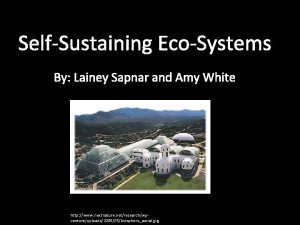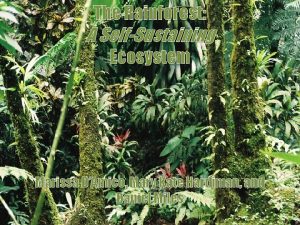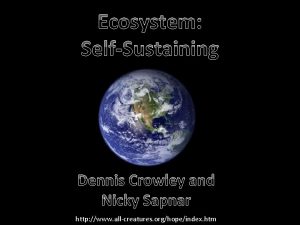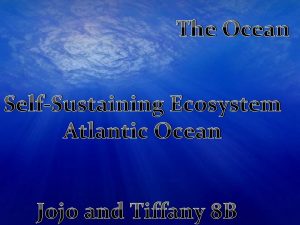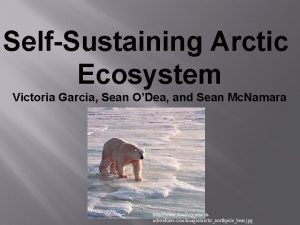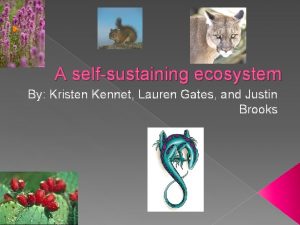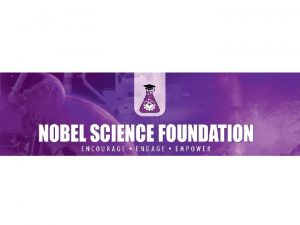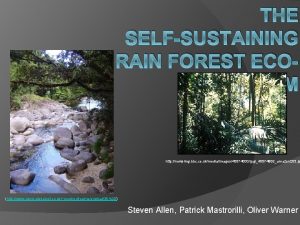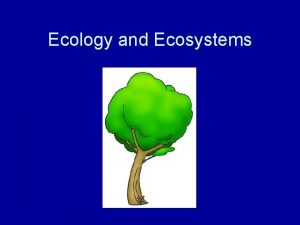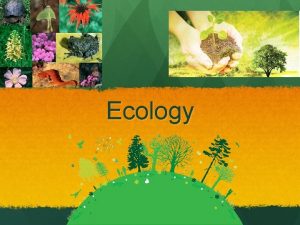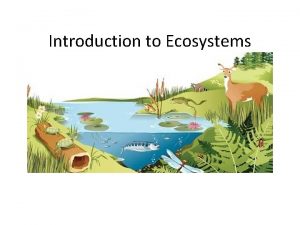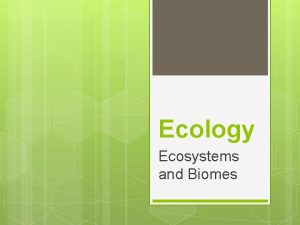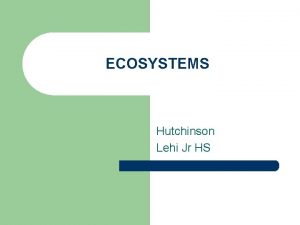Ecology Ecosystems Ecology An ecosystem is a selfsustaining























- Slides: 23

Ecology

Ecosystems Ecology An ecosystem is a self-sustaining community of organisms and the non-living environment with which they interact. An ecosystem is the basic unit of ecology.

Biogeochemical Cycles A biogeochemical cycle is the cyclic movement of a substance (e. g. water, carbon, nitrogen, phosphate) through the biotic (living) and abiotic (non-living) environments. Biogeochemical cycles are a key component of ecosystems ecology.

The Carbon Cycle Understanding of the carbon cycle is critical to the understanding of climate change

The Nitrogen Cycle Note the key role of mutualism between nitrogen-fixing bacteria and their plant hosts. Not shown is the huge contribution of anthropogenic (manmade) ammonia and nitrates.

Humans Play a Major Role in the Nitrogen Cycle Aerial fertilization (with nitrogen) of sugar beets.

Excessive Amounts of Nitrogen Fertilizer Harm Ecosystems A seasonal “dead zone” where virtually all marine life is killed stretches off the Mississippi Delta. Why? About 1. 5 million metric tons of nitrogen from fertilizer runoff promotes algal and bacterial blooms that deplete oxygen from the water.

The Water Cycle Only about 40% of precipitation on land comes from water evaporated over oceans; roughly 60% comes from transpiration of water through plants.

The Percentage of Available Global Freshwater is Very Small

Clean Freshwater Is a Precious and Often Scarce Resource

We’re in the Driver’s Seat Human Activities Dominate Many Biogeochemical Cycles

Human Activities Significantly Alter the Abiotic Environment

Greenhouse Gases and Global Warming

Glaciers are Receding Worldwide The Andean Qori Kalis Glacier in 1978 (left) and 2000 (right).

Human Activities Significantly Alter the Abiotic Environment

The Seasonal “Ozone Hole” Over Antarctica Environmental news isn’t all bad: with the sharp reduction of triflurocarbons (ozone depleting chemicals), ozone levels are returning to normal.

Biodiversity What is it? Should we strive to preserve it?

Biodiversity Varies Naturally There is a trend towards more species in warmer, wetter areas and fewer in colder and drier areas. Numbers of bird species occupying areas of North America.

There are Biodiversity “Hotspots” Biodiversity hotspots for tropical rain forest and chaparral ecosystems. Less than 1% of Earth’s surface supports 20% of known plant species and probably a greater portion of animal species.

Biodiversity is Being Lost Rapidly Through Extinction How rapid is the current rate of extinction? The number’s hard to pin down, but generally accepted estimates put it at 10 -100 times the rate before extensive human–induced environmental modifications. For example, in the U. S. ~ 225 plant species have become extinct in the past 50 years and about 650 of the remaining 20, 000 species are threatened.

What are the Causes of Accelerated Extinction? Habitat loss. Pollution. Overharvesting. Effect of rabbit introduction Australia Introduction of exotic species and diseases. These factors often work in combination to eliminate species.

Biodiversity – Tough Questions and Choices What’s the minimum amount of biodiversity required to support a health ecosystem? What’s the minimum amount of biodiversity required to support a healthy environment for humans?

Biodiversity – Tough Questions and Choices What is an acceptable trade-off between species protection vs. restraints on human activity? Which species are of special concern for a healthy ecosystem/human environment? Organisms don’t respect political boundaries. How can biodiversity protection be legislated and instituted across international borders?
 Phosphorus cycle pearson education
Phosphorus cycle pearson education Chapter 55 ecosystems and restoration ecology
Chapter 55 ecosystems and restoration ecology Ecosystem ecology
Ecosystem ecology Ecology terms
Ecology terms Ecosystem ecology
Ecosystem ecology Difference between ecosystem and ecology
Difference between ecosystem and ecology Difference between ecosystem and ecology
Difference between ecosystem and ecology Ecosystem ecology
Ecosystem ecology Ecosystem ecology definition
Ecosystem ecology definition Ecosystem ecology
Ecosystem ecology Ecology ecosystem
Ecology ecosystem Ecosystem ecology
Ecosystem ecology Principles of ecology 2 flow of energy in an ecosystem
Principles of ecology 2 flow of energy in an ecosystem Grade 7 ecosystems
Grade 7 ecosystems Interest grabber
Interest grabber Parasitism examples
Parasitism examples How do ecosystems work
How do ecosystems work Frog life cycle
Frog life cycle What are the two main categories of ecosystems
What are the two main categories of ecosystems Main ecosystems
Main ecosystems Chapter 42 ecosystems and energy
Chapter 42 ecosystems and energy Photic and aphotic zones
Photic and aphotic zones Section 3 energy in ecosystems
Section 3 energy in ecosystems Describe freshwater
Describe freshwater


